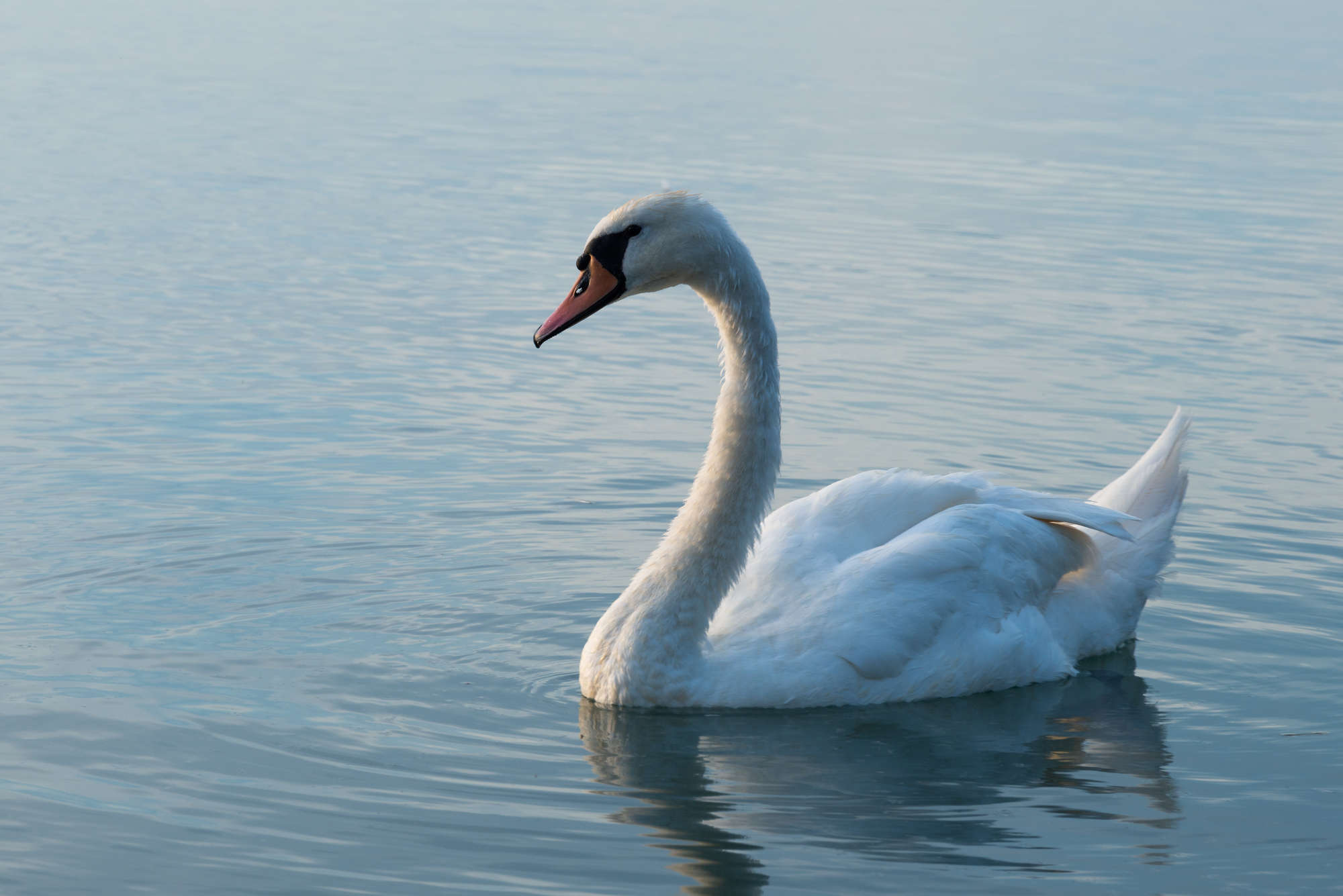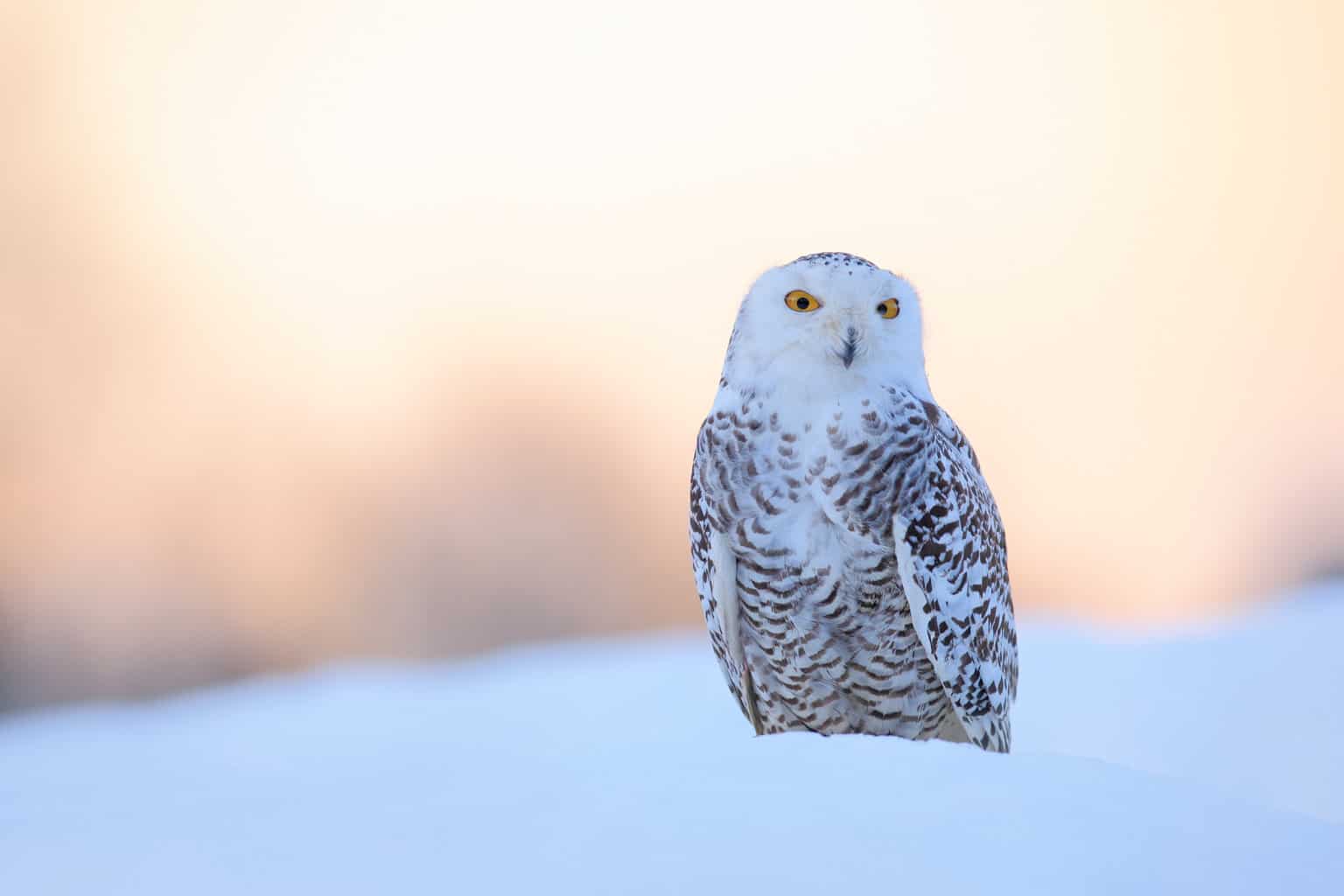The birding world is full of many species with varied colors – blue, red, green, orange, yellow – but when you’re out in the field looking for birds, a crisp, white bird can stick out as much as any other color.
Here are some of the most common white birds in North America. For the sake of this article, we won’t list every partially white bird, which would include a multitude of ducks, grebes, plovers, cuckoos, woodpeckers, and more. Rather, we’ll focus on birds that are almost entirely white.
Swans

Some of the most elegant birds in North America are the continent’s swans – including its two native species, the trumpeter and tundra swan.
The mute swan is native to Europe and Asia but has been introduced to parts of North America, mostly in the Great Lakes states, where they have developed resident populations.
Despite their beauty, mute swans are known to be aggressive toward native birds, including other swan species, so they’re sometimes lethally removed by wildlife agencies attempting to curb their populations or eliminate them entirely.
Trumpeter swans are the largest native waterfowl species in North America, weighing over 25 pounds, according to the Cornell Lab of Ornithology’s All About Birds.
Their range is still splotchy across the continent as they work their way back from near collapse in places like the Midwest.
Tundra swans, which aren’t nearly as big as their relatives, breed in the most northern stretches of the continent. However, their winter and migratory range allows many more Americans in the Midwest, parts of the coast, and the Rockies to catch a glimpse of them as they pass through.
The easiest way to tell the difference between the three swan species is by looking at their bills. The mute swan has a bulky orange bill with a black knob on top, while the tundra swan has a black bill with a small yellow mark just in front of the eye.
Also, the trumpeter swan’s bill is black, with black coloring coming to the eye at a more direct V-shaped point than that of the tundra swan.
Snow and Ross’s geese

Sticking with America’s white waterfowl, next we have two goose species.
First is the snow goose, a breeder of the Arctic tundra that migrates to the Great Plains and some sections of the coast each winter. At least a small part of most states is within the species’ migration path.
Each year, parts of the Great Plains see the skies fill with huge flocks of white as snow geese pass through:
The Ross’s goose has a slightly smaller migratory path, with less reach to the Rockies and west of the Mississippi River, but they’re fairly similar birds.
Snow geese have larger bodies and bills than Ross’s geese, which have stubby little bills with graying near the base and without a black line along the bottom of the bill that bedecks the snow goose.
American white pelican

One of two North American pelican species, the American white pelican is one of the continent’s largest birds, and might even surprise some first-time viewers with how large they look up close.
Often standing upwards of four feet tall, white pelicans can dwarf even large birds like egrets.
Often seen in flocks, pelicans have recognizable black borders to their wings in flight and orange bills, but other than that, they have bright white bodies.
They’re found in bays, marshes, and large lakes, mostly breeding in sporadic areas throughout the northern Plains states. They spend the winters in Central America and Gulf Coast states as well as parts of California and Arizona.
Gulls and terns

“Seagulls” is a blanket term often used for every white gull seen from parking lots to beaches, but there are more than two dozen different gull species to be seen throughout North America.
The herring gull, western gull, ring-billed gull, glaucous-winged gull, great black-backed gull, and laughing gull are among common gulls for certain areas of the continent, and all the different species can often be difficult to tell apart.
In addition to size and location, back and wing color, bill shape, size, and color, and leg color are among the top ways to best tell between gulls.
Terns are seabirds that are closely related to seagulls. They’re often similarly colored and occupy similar habitats, but they are typically smaller and more slender.
Terns are mostly ocean-going birds, and they often feed by diving straight down into the water to catch small fish. Some terns may be found inland, including the Caspian tern, which resides in areas of the western United States and Canada and the Great Lakes region.
One of the most interesting North American migrations is that of the Arctic tern. It’s a migration that covers about 25,000 miles (via All About Birds) as they travel from one pole to the other every year.
Other seabirds
Gulls and terns aren’t the only seabirds that may be white. The northern gannet, masked booby, and rare North American tropicbirds are all mostly white.
From below, many petrels, shearwaters, and albatrosses look almost entirely white even though their backsides are mostly darker colors.
Egrets, ibises, herons, storks, and cranes

Tall, long-legged birds like egrets are some of the most frequently seen white birds, as they often do little to conceal themselves in open areas like marshes and wetlands.
Immature little blue herons are also almost completely white, as are white morph reddish egrets.
Cattle egrets, snowy egrets, and great egrets are all mostly white, as are white morph great blue herons.
Great egrets and white morph great blue herons, a southern Florida bird previously considered a separate species, are the tallest, at over three feet. Snowy, little, and cattle egrets all check in at around two feet tall.
The great egret’s breeding range stretches from Texas along the coast all the way to the Northeast, as well as through parts of the Midwest. The snowy egret has a spotty range that includes the Gulf States and Great Basin, and the cattle egret is a mostly southern species in North America.
The best way to tell these wading birds apart is to look at their bills, which range from black (snowy egret) to orange (great egret, cattle egret) and long and thin (snowy) to short and stocky (cattle).
In some areas of the country such as Wisconsin, Florida, or Texas, it’s also possible to see a whooping crane at certain times of the year. These birds stand over four feet tall and are under critical management and reintroduction plans after nearly going extinct in recent history.
If you’re in the Southeast (mostly Florida), you may also see a wood stork, a tall, mostly white bird, or a white ibis, a pink-legged, pink-billed/faced bird of just over two feet tall.
Ptarmigans

Ptarmigans are members of the grouse family. If you see one in the summer months, you would never place it on a list of white birds, but come the winter, ptarmigans transform into beautiful white plumage to camouflage themselves in their snowy, northern habitats.
All three North American ptarmigan species – white-tailed, rock, and willow ptarmigans – are almost entirely white in the winter and mostly brown in the summer.
The white-tailed ptarmigan is the most likely to be seen in the Lower 48, with select populations in areas like Montana, Washington, California, Utah, Colorado, and New Mexico.
Rock ptarmigans and willow ptarmigans are pretty much exclusive to Canada and Alaska.
Willow ptarmigans may be seen in large groups during the winter. According to All About Birds, they’ve been known to congregate in flocks of up to 2,200 birds and have even been found off-shore on ships at sea or oil-drilling equipment.
Snowy owl

A northern favorite, snowy owls winter in much of Canada and the upper reaches of the United States, where a sighting provides serious excitement for birdwatchers.
And in certain years, when more snowy owls migrate further south (called an irruption year), snowy owls become the stars of the winter.
Immature birds and females are mostly white with some dark markings along their bodies. On males, that coloring fades and they become almost entirely white. Both sexes have signature yellow eyes.
When they come south for the year, those in search of snowy owls often have the best luck in wide open areas, including roadside fences, barren agricultural fields, and near the sides of large open bodies of water.
Snow bunting and McKay’s bunting

After a list of mostly larger birds, we finally touch on the little snow bunting, measuring about 5.9 inches long, and between 1.1 and 1.6 ounces in weight, according to All About Birds.
Like some of the other northern birds on this list, snow buntings use their white color as camouflage. But come winter, when they begin to head south, their crisp white plumage turns a bit brown.
Interestingly, their change in color from brown back to white is caused by males rubbing their bodies and heads in the snow, wearing down the brown tips of their feathers back into their shiny summer whites, All About Birds states.
Their non-breeding range extends across almost the entire northern United States and birds may even reach parts of southern states like Arkansas, Tennessee, and the Carolinas, to name a few.
Despite the fact that they’re seen in large groups and there are still millions of them across the continent, their numbers have undergone significant declines in the past few decades.
The American Bird Conservancy reports that the Christmas Bird Count revealed a 64-percent drop in North American populations over the past four decades, with climate change posing problems for this far northern species.
McKay’s buntings are residents of several small islands off the coast of Alaska, and there are likely only a few thousand of them, according to the National Audubon Society, which also states that they may interbreed with snow buntings on islands like St. Lawrence Island or the Pribilofs.
Frequently Asked Questions
What owl is all white?
The snowy owl is almost all white. Males are pure, crisp white, while immature and female birds will typically display more dark barring on otherwise white bodies.
Barn owls may look mostly white from the front, but their backs are usually a tan or brown color. Other owl species do have partially white undersides, but none compare to the snowy owl.
What dove is white?
More common in movies and TV shows than in real life, releasing white doves for events like weddings is frowned upon by some advocacy organizations.
The birds that are released are actually homing pigeons that are bred to be all white.
What about albino or leucistic birds?
Albino birds completely lack pigment, while leucism is not a full lack of color. Rather, birds may appear a mix of their normal colors and white.
These can occur in all types of animals but are very rare. According to the National Wildlife Federation, a study of 30,000 birds in California found only 17 had some degree of albinism.
Leucism is more common than albinism, according to Avian Report, but neither is a regular sight in birds.

